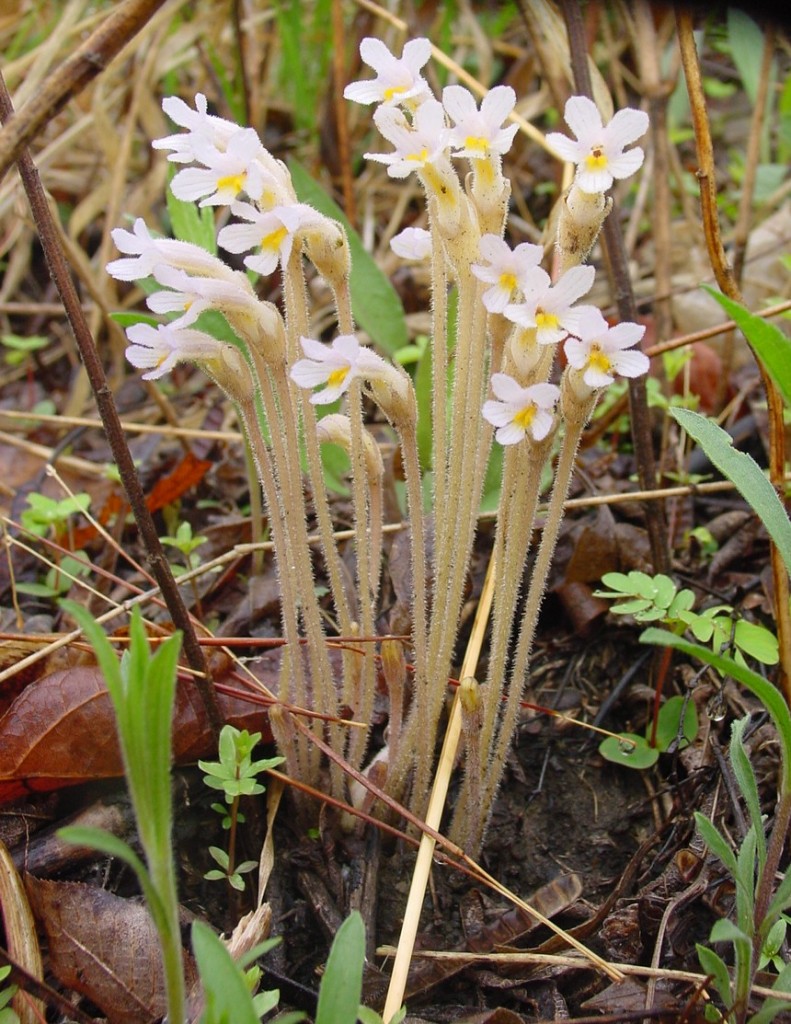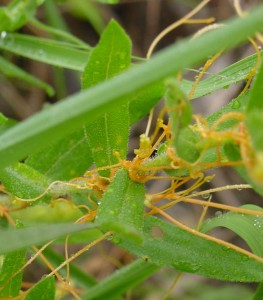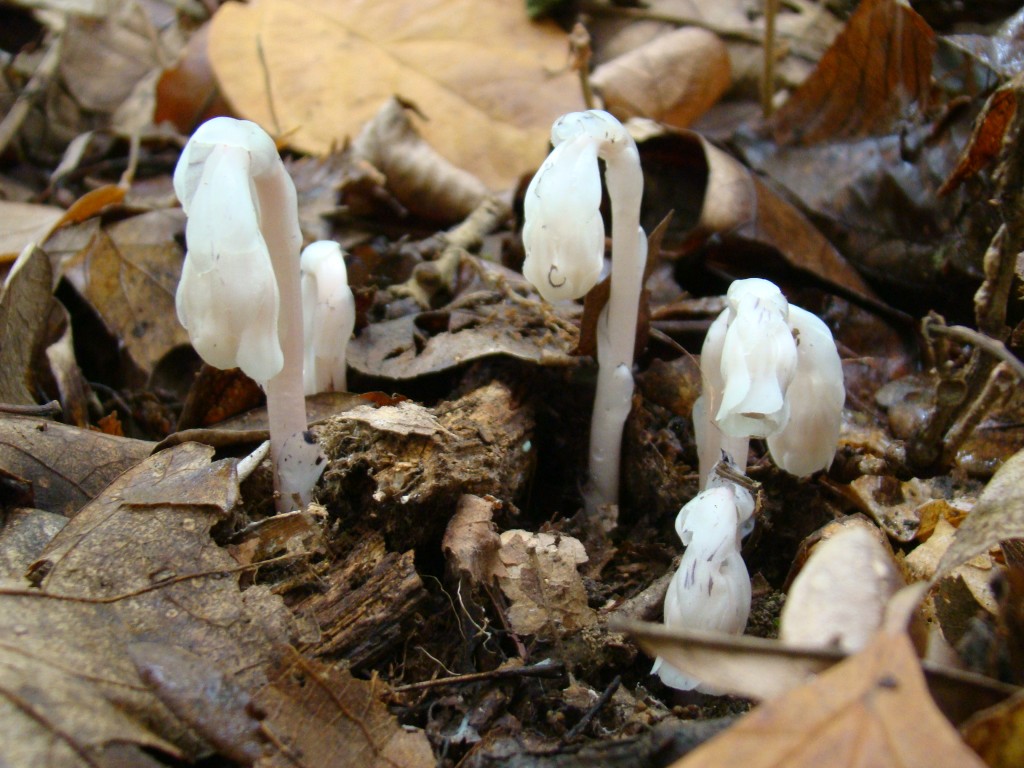Vampires: Right in the bluff’s backyard?

Broomrape (Orobanche uniflora) growing near Miles Cemetery Hill Prairie. Photo courtesy Bob Weck, Southwestern Illinois College.
The recent celebration of Halloween, replete with goblins, ghouls, and witches or the continuing popularity of vampire-themed novels and movies trick us into believing that bloodsucking harpies can only be found among mammals and horror-storied humans. That is far from true.
In the normal scheme of things we see all plants as green, carrying out photosynthesis to manufacture their own life-sustaining food. But, a hand-full of flowering plants in our neck of the southwestern Illinois woods are plant vampires, obtaining nutrients, food and water by parasitizing other plants.
Broomrape (Orobanche uniflora) lacks chlorophyll and obtains all its nourishment by attaching its roots to the roots of oaks, asters, and goldenrods. Broomrape is fairly common in our upland forests. Several branchless, leafless yellowish-brown, hairy, 5-8-inch stalks grow from its root structure in late spring (April-June).
A single white to light violet, 1-inch tubular flower emerges at the tip of each stalk. Broomrape was once commonly called “one-flowered cancer root” and was used by early Euro-American settlers as a folk remedy. Native American peoples used the various species of this plant for food, eating them either roasted or raw, and for a wound medicine, most frequently by chewing both plant and root parts, or, alternately, by drying roots and then applying the mix to wounds, including gunshot wounds. In the East, broomrape is often called “ghost pipe.”
Dodder is an often-overlooked plant, even as it twines its leafless threadlike stems and attaches by suckers to its showy host plants. Ten species of dodder occur in Southwestern Illinois; all are in the genus Cuscuta, a member of the morning glory family. Like broomrape, dodder also lacks any chlorophyll and each species parasitizes a specific host plant such as goldenrods, asters, sunflowers, ragweeds, fleabanes, or milkweeds. Dodder can be found in our woodlands and open spaces.

Dodder (Cuscuta sp.) growing at Fults Hill Prairie Nature Preserve. Photo courtesy Bob Weck, Southwestern Illinois College.
Root suckers grow from the fibrous thin stems and pierce parts of leaves and stems of the host to extract all required nutrients. Tiny, quarter-inch wide, yellow-to-white flowers bloom in clusters along the dodder stems from mid-summer to early fall.
Old folk names for dodder include devil’s guts, devil’s hair, devil’s ringlet, goldthread, hailweed, hairweed, hellbine, love vine, pull-down, strangleweed, angel hair, and witch’s hair. Among Native Americans, dodder was used as a poultice for bruises. Members of the Pawnee tribe believed an infusion made with dodder could divine the sincerity of suitors, and also used the plant to make a yellow dye. Pauite women used the plants as a contraceptive and the Paiute name for dodder translates as “woman without children.” Today, dodder seed is used in some Asian herbal medicines for osteoporosis.
Beech trees are not native to Monroe or St. Clair Counties and the few present were no doubt planted as ornamentals. They are native, however, in the moister woods of more southern Illinois, and can be found in good numbers in southern Randolph County. Beech trees are host for another parasitic plant.
Beechdrops (Epifagus virginiana) also lack chlorophyll and get all their energy from beech tree roots. Beechdrops have branched, wiry, brown stems that can grow up to 20″ tall, all in a cluster around beech trees. In August through October, beechdrops produce tiny, ½ long, tubular, white flowers with purplish-brown stripes.
A highly bitter tea from all parts of beechdrops was once used as an astringent and for diarrhea and mouth sores by both Native American and Euro-Americans.
Two parasitic plants in our region do have chlorophyll and can produce much of their nutrient needs on their own, but take all their requirements for water from other host plants.
One of these “water vampires” is bastard or false toadflax (Comandra umbellata) which grows in our bluffland hill prairies and glades. It parasitizes asters, goldenrods, pussytoes, roses, various bramble berry species, and several native grasses and sedges to obtain water. False toadflax’s foot-tall yellow-green stems, with alternate narrow leaves, support clusters of quarter-inch long, whitish flowers that can bloom from May through August.
Wood betony (Pedicularis canadensis) or lousewort can be found in the hill prairies and dry ridge tops in our blufflands. Like toadflax, it obtains water from a wide number of species. Several hairy stems emerge from clumps of fern-like basal leaves in spring and grow to over a foot by bloom time in May. The snapdragon-like, inch-long, yellow flowers are densely clustered at the top of the stem. As the second common name implies, the plant was used to rid livestock of lice. Plant parts and roots also were used for medicines for stomach or bowel ailments and for anemia.
Rather than parasitizing living plants, an alternate nutrient-extraction method is employed by saprophytes that take all their energy needs from decaying organic matter. Two plants in our area are saprophytic and lack chlorophyll, but don’t parasitize other plants; rather, they parasitize fungi which are decomposing top soils.
Spring coral-root orchid (Corallorhiza wisteriana) is a saprophyte. It grows throughout our bluff’s forest and blooms sometime between March and May. Coral root has a single, purplish-brown stem, up to 16″ high, with white-tipped, purple-striped flowers alternating up the stem. This orchid depends on fungi throughout its entire life cycle, with fungi penetration beginning even in the seed-formation life stage.

Indian pipe (Monotropa uniflora) growing at Stemler Cave Woods Nature Preserve. Photo courtesy Bob Weck, Southwestern Illinois College.
Indian pipe (Monotropa uniflora) is perhaps the most interesting flowering saprophytic plant in our area. It grows throughout the blufflands, usually where there is dense leaf mulch and litter. Several whitish, fleshy stems rise from the plant’s roots to a height of about 8 inches. A single, whitish, inch-long flower droops to form the “pipe,” then becomes erect as the fruit forms. Indian pipe blooms can be found from late August into October.
Both Native Americans and early Euro-American settlers used the juice from Indian pipe for treating eye sores. Early American folklore attributes the common name to the plant’s first appearance exactly at the spot where a Native American had knocked the ashes from his pipe onto the forest floor. Native Americans in British Columbia long held the belief that an abundance of Indian pipe plants in the woods foretold a good mushroom season in the next year. The pale appearance and its method of gaining nutrients from decaying materials gave Indian pipe the alternate common names of “ghost plant or ghost pipe” (just like broomrape), or, more tellingly, “corpse plant.”
Making a living on corpses, vampiric stabbing in and draining life’s blood, erecting a flower only by sucking the juices of another life is a one-sided, essentially folkloric telling of the life made possible by parasitism. Detailed ecological studies now tell a more nuanced tale of biological communities – trees and shrubs, herbacious flowering plants, fungi, bacteria, molds, lichens, and fauna – and the non-biological substrate of sun, rain, rocks and soils all tied together at a microscopic level of mutual back-and-forth give and take.
Unlike the animal kingdom, where parasitic bloodletting is viewed as a savage study in horror, in the world of plants, parasitism simply frames the benefits and realities of an inter-dependent mutualism.
CLIFFTOP, a local nonprofit organization, is focused on preserving and protecting area bluff lands.
A version of this article appeared in the 16 November 2012 edition of the Monroe County Independent.
© 2012 all content rights reserved Clifftop NFP
Comments are currently closed.
